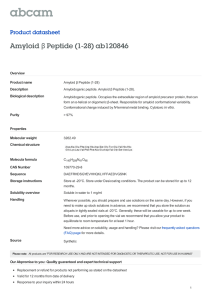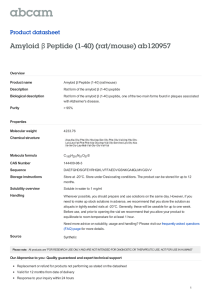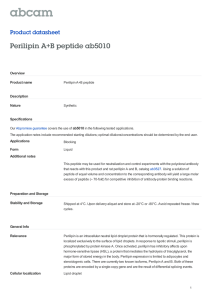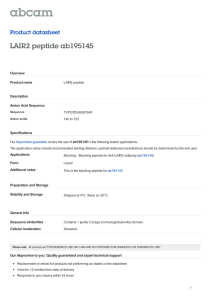Amyloid beta peptide (1-42) (human) protocol
advertisement
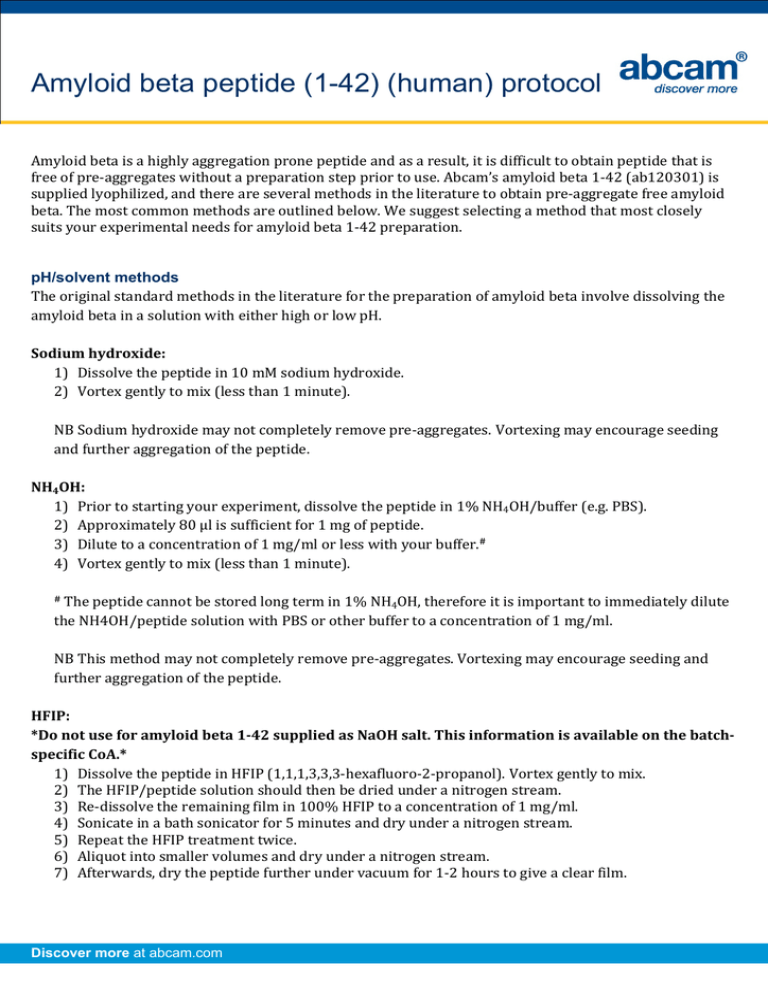
Amyloid beta peptide (1-42) (human) protocol Amyloid beta is a highly aggregation prone peptide and as a result, it is difficult to obtain peptide that is free of pre-aggregates without a preparation step prior to use. Abcam’s amyloid beta 1-42 (ab120301) is supplied lyophilized, and there are several methods in the literature to obtain pre-aggregate free amyloid beta. The most common methods are outlined below. We suggest selecting a method that most closely suits your experimental needs for amyloid beta 1-42 preparation. pH/solvent methods The original standard methods in the literature for the preparation of amyloid beta involve dissolving the amyloid beta in a solution with either high or low pH. Sodium hydroxide: 1) Dissolve the peptide in 10 mM sodium hydroxide. 2) Vortex gently to mix (less than 1 minute). NB Sodium hydroxide may not completely remove pre-aggregates. Vortexing may encourage seeding and further aggregation of the peptide. NH4OH: 1) Prior to starting your experiment, dissolve the peptide in 1% NH4OH/buffer (e.g. PBS). 2) Approximately 80 µl is sufficient for 1 mg of peptide. 3) Dilute to a concentration of 1 mg/ml or less with your buffer.# 4) Vortex gently to mix (less than 1 minute). The peptide cannot be stored long term in 1% NH4OH, therefore it is important to immediately dilute the NH4OH/peptide solution with PBS or other buffer to a concentration of 1 mg/ml. # NB This method may not completely remove pre-aggregates. Vortexing may encourage seeding and further aggregation of the peptide. HFIP: *Do not use for amyloid beta 1-42 supplied as NaOH salt. This information is available on the batchspecific CoA.* 1) Dissolve the peptide in HFIP (1,1,1,3,3,3-hexafluoro-2-propanol). Vortex gently to mix. 2) The HFIP/peptide solution should then be dried under a nitrogen stream. 3) Re-dissolve the remaining film in 100% HFIP to a concentration of 1 mg/ml. 4) Sonicate in a bath sonicator for 5 minutes and dry under a nitrogen stream. 5) Repeat the HFIP treatment twice. 6) Aliquot into smaller volumes and dry under a nitrogen stream. 7) Afterwards, dry the peptide further under vacuum for 1-2 hours to give a clear film. Discover more at abcam.com NB This method may not completely remove pre-aggregates. Vortexing and sonication may encourage seeding and further aggregation of the peptide. Recommended reading The most commonly adopted method is to use HFIP. Recently, the use of HFIP has been suggested by a number of groups to cause enhanced aggregation. Ryan et al., made a detailed comparison of NH4OH and HFIP treatment and reported that treatment with NH4OH produced a much more homogenous and monomeric solution than HFIP (Ryan et al., 2013). Organic solvents: These have been used when high or low pH may not be appropriate. Amyloid beta is soluble in DMSO, but again, this method may not completely remove pre-aggregates. However, these methods are fast and inexpensive and may be appropriate for experiments where the presence of some pre-aggregates is not particularly problematic. Size exclusion chromatography methods Recent literature (Hellstrand et al., 2010; Johnson et al., 2011) has shown that size exclusion chromatography (SEC) may be a suitable method for the complete removal of aggregates from amyloid beta. Hellstrand et al. purified the peptide using SEC twice but Johnson et al. showed that once is sufficient. Disadvantages to this method include the requirement for a reasonably large amount of material, lowering the concentration on the peptide on the column and a lengthy and expensive preparation step. However, if it is crucial to the experiment that as many pre-aggregates are removed as possible this method may be superior to a pH or solvent method. References: Hellstrand E, Boland B, Walsh DM, Linse S. (2010) Amyloid β-protein aggregation produces highly reproducible kinetic data and occurs by a two-phase process. ACS Chem Neurosci. 1(1):13-8. Johnson RD, Schauerte JA, Wisser KC, Gafni A, Steel DG. (2011) Direct observation of single amyloid-β(140) oligomers on live cells: binding and growth at physiological concentrations. PLoS One 6(8):e23970. Ryan TM, Caine J, Mertens HD, Kirby N, Nigro J, Breheney K, Waddington LJ, Streltsov VA, Curtain C, Masters CL, Roberts BR. (2013) Ammonium hydroxide treatment of Aβ produces an aggregate free solution suitable for biophysical and cell culture characterization. PeerJ. 1:e73. Discover more at abcam.com
